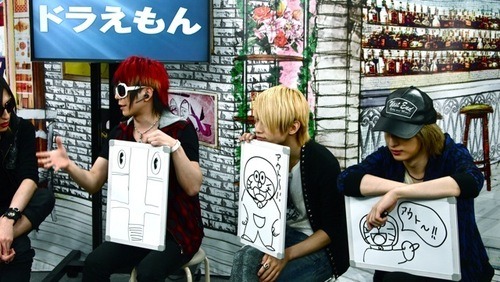 Most textbooks explain the usage of カタカナ as mostly for loan words, emphasis, and onomatopoeia.
Most textbooks explain the usage of カタカナ as mostly for loan words, emphasis, and onomatopoeia. For example :
The picture above is of Japanese candies, however, most of them are written in Katakana. Many candy names are loan words from the English language. "Kit Kat", "Pinky", and "Hi-Chew". I think they used カタカナ to show the "foreign-ness" of the candy. Using ひらがな or かんじmight give the merchandise a more familiar atmosphere rather than a foreign and innovative feel.
In the picture to the left,
カタカナ is used for onomatopoeia purposes. The Japanese textbooks explain how katakana is used to express onomatopoeia.
"チン” and "ガ-シ” is used for the sounds of the elevator. The "chin" of the elevator bell and the "gaashi" of the elevator door. Using カタカナ for onomatopoeia purposes allows the reader to quickly pick up and differentiate between the sound effects and the actual dialogue of the cartoon.
"チン” and "ガ-シ” is used for the sounds of the elevator. The "chin" of the elevator bell and the "gaashi" of the elevator door. Using カタカナ for onomatopoeia purposes allows the reader to quickly pick up and differentiate between the sound effects and the actual dialogue of the cartoon.
This picture shows ドラえもん。I realized that half this character's name is ひらがな and the other half is カタカナ. The purpose of this might be to emphasize his name more. Since ドラえもん is a very popular character, I believe his name was written this way to
show his uniqueness as a "mascot" of the Japanese cartoon culture.
カタカナ,ひらがな, and かんじ are all used for different purposes. I personally believe that it is usually up to the actual writer to determine how he or she wants to combine these different Japanese characters. Indeed, there is a set reason for these different characters for example カタカナ is used for (usually) loan words, emphasis, or onomatopoeia, however, it all depends. There are always exceptions.


Very interesting comment about ドラえもん. Why don't you look into the origin of ドラ焼き, which is his favorite food. My assumption will be it came from there. What do you think?
ReplyDeleteFor the other opinions, I totally agree with your opinion. One interesting thing that I found in your photo was "笹かま風 ドロップ". This is the combination of ひらがな、カタカナ、and 漢字. Why do you think the company made the selection of letters as above?
I agree with your comment about the use of カタカナ in manga (for onomatopoeia). In addition, I've noticed that sometimes when the sound is coming from the characters in the manga, the sound is written in ひらがな (for example: あああああああ!). I think that using カタカナ will help distinguish background sounds (like the sounds of an elevator) from a sound like a character screaming. Though now that I think about it more carefully, screaming isn't really onomatopoeia, is it?...Anyway, I really liked your analysis :D
ReplyDeleteGood job finding all those visuals for katakana! I've actually never noticed ドラえもん, interesting analysis. I like your point about the repackaging of American candies to fit the Japanese consumers using katakana to bring familiarity but yet it conveys a "foreign-ish" sense.
ReplyDeleteマーギ
ユジンニヤちゃん!
ReplyDeleteI love your picture of all the candies with their names in かたかな XP and about ドラえもん's name ^^" thought I'd spare you the wikipedia trip:
(as copied from Wikipedia...)
The name "Doraemon" translates roughly to "stray". Unusually, the name "Doraemon" (ドラえもん) is written in a mixture of two Japanese scripts: katakana (ドラ) and hiragana (えもん). "Dora" is from "dora neko" (stray cat, どら猫), and is a corruption of nora (stray). "Emon" is a component of male given names, such as Goemon, though no longer as popular as in the past. "Dora" is not from dora meaning gong, but due to the homophony, the series puns on this, with Doraemon loving dorayaki.
また、あした =)
Is it just me or is カタカナ also とてもかわいいですか。I feel like it could also be used to emphasize the cute simplicity of a character, if that makes sense? I feel like ひらがなと感じ would lend a serious tone to a character.
ReplyDeleteI really like your analysis Euginia! I've never noticed ドラえもん either, even though Doraemon is one of my favorite character L0L!I just found out that Doraemon's favorite food is Dorayaki and "Dora" comes from the food name(dorayaki). This katakana "Dora" is emphasized because it's his favorite dabemono. I think this is really cute idea. In Korean, as we sometimes use dots above the Hangul words for an emphasis, I think the use of Katakana is also the way of emphasizing!
ReplyDeleteOverall I agree with your examples and analysis about the use of Katakana. :)
Hi, I'm in Nazikian-sensei's 4th year class. I really like your last point about how flexible Japan's three writing systems really are. While they follow certain conventions, authors will often use them in different ways to make their writing a little more colorful. That said, you almost always see foreign words in カタカナ no matter what.
ReplyDeleteEugenia! I think your bit about the cartoon character with the name half in hiragana and half in katakana is really interesting. I wonder if there are a lot of other words written like this? Or is this purely because of his role as a mascot for Japan?
ReplyDelete